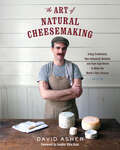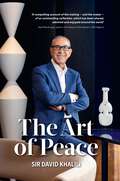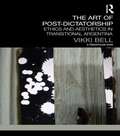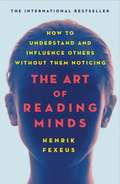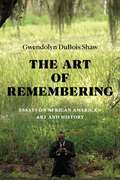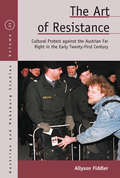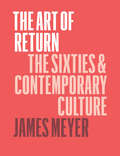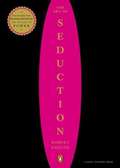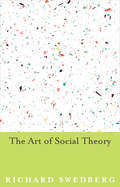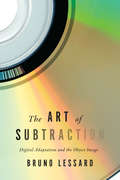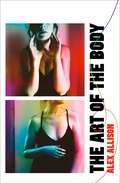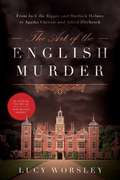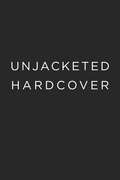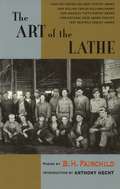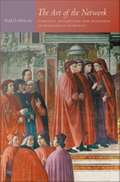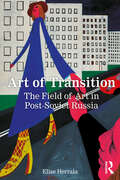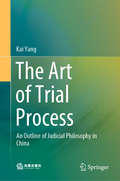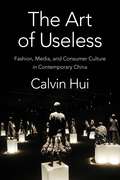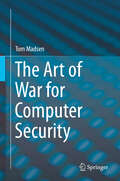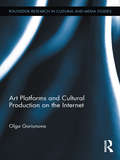- Table View
- List View
The Art of Natural Cheesemaking: Using Traditional, Non-Industrial Methods and Raw Ingredients to Make the World's Best Cheeses
by null David AsherIncluding more than 35 step-by-step recipes from the Black Sheep School of CheesemakingMost DIY cheesemaking books are hard to follow, complicated, and confusing, and call for the use of packaged freeze-dried cultures, chemical additives, and expensive cheesemaking equipment. For though bread baking has its sourdough, brewing its lambic ales, and pickling its wild fermentation, standard Western cheesemaking practice today is decidedly unnatural. In The Art of Natural Cheesemaking, David Asher practices and preaches a traditional, but increasingly countercultural, way of making cheese—one that is natural and intuitive, grounded in ecological principles and biological science.This book encourages home and small-scale commercial cheesemakers to take a different approach by showing them:• How to source good milk, including raw milk;• How to keep their own bacterial starter cultures and fungal ripening cultures;• How make their own rennet—and how to make good cheese without it;• How to avoid the use of plastic equipment and chemical additives; and• How to use appropriate technologies.Introductory chapters explore and explain the basic elements of cheese: milk, cultures, rennet, salt, tools, and the cheese cave. The fourteen chapters that follow each examine a particular class of cheese, from kefir and paneer to washed-rind and alpine styles, offering specific recipes and handling advice. The techniques presented are direct and thorough, fully illustrated with hand-drawn diagrams and triptych photos that show the transformation of cheeses in a comparative and dynamic fashion.The Art of Natural Cheesemaking is the first cheesemaking book to take a political stance against Big Dairy and to criticize both standard industrial and artisanal cheesemaking practices. It promotes the use of ethical animal rennet and protests the use of laboratory-grown freeze-dried cultures. It also explores how GMO technology is creeping into our cheese and the steps we can take to stop it.This book sounds a clarion call to cheesemakers to adopt more natural, sustainable practices. It may well change the way we look at cheese, and how we make it ourselves.
The Art of Peace
by Sir David KhaliliIn 1967, Sir David Khalili finished his military service in Iran and travelled to study in the United States with $750 - his remaining royalties from a book he wrote when he was just 14. Over the course of the next five decades he single-handedly, piece by piece, assembled eight of the finest art collections in their field, ultimately becoming one of the world's greatest collectors, about whom Queen Elizabeth II once said: 'It is scary how much this gentleman knows about art.'For the first time, Sir David shares his extraordinary journey: one that has taken him through the souks of North Africa, the auction houses of Europe and the United States, the bazaars of South Asia, and far beyond. Through a riveting collection of real-life adventures, he reveals his collecting strategy, business ethics and what motivates him to continuously collect, conserve, research, publish and exhibit the treasures in his collections. Through his story, Sir David questions how the undeniable power of art can be harnessed to foster greater peace and unity worldwide. No one is better placed to enlighten us.
The Art of Post-Dictatorship: Ethics and Aesthetics in Transitional Argentina
by Vikki BellSince the end of the last dictatorship in 1983, Argentina’s visual artists and art-activists have been central to campaigns to demand the criminal prosecution of those initially granted amnesty and to a variety of commemorative projects. In The Art of Post-Dictatorship: Ethics and Aesthetics in Transitional Argentina Vikki Bell examines this involvement and intervention. She argues that the problematics that arise within the aesthetic realm cannot be understood solely through an art-historical approach; instead, they must be understood as a constitutive part of a broader collective endeavour. In this sense, the ‘art’ of post-dictatorship is not something that belongs to art or the artists themselves, but is about how the subjectivities and imaginations of new generations are constituted and entwined with questions of response, ethics and justice. It concerns how people align themselves between the past and the future. This book will be an invaluable resource for those studying the law, politics, art and sociology of contemporary Argentina as well as those concerned more widely with transitional justice and the politics of memory.
The Art of Public Space: Curating And Re-imagining The Ephemeral City
by Kim GurneyA journey through Johannesburg via three art projects raises intriguing notions about the constitutive relationship between the city, imagination and the public sphere- through walking, gaming and performance art. Amid prevailing economic validations, the trilogy posits art within an urban commons in which imagination is all-important.
The Art of Reading Minds: How to Understand and Influence Others Without Them Noticing
by Henrik FexeusThe internationally bestselling guide to "mind-reading" by influencing those around you via non-verbal communication, from human psychology expert Henrik Fexeus. How would you like to know what the people around you are thinking? Do you want to network like a pro, persuade your boss to give you that promotion, and finally become the life of every party? Now, with Henrik Fexeus's expertise, you can. The Art of Reading Minds teaches you everything you need to know in order to become an expert at mind-reading. Using psychology-based skills such as non-verbal communication, reading body language, and using psychological influence, Fexeus explains how readers can find out what another person thinks and feels– and consequently control that person’s thoughts and beliefs. Short, snappy chapters cover subjects such as contradictory signs and what they mean, how people flirt without even knowing it, benevolent methods of suggestion and undetectable influence, how to plant and trigger emotional states, and how to perform impressive mind-reading party tricks. Fexeus gives readers practical (and often fun) examples of how to effectively mind-read others and use this information, benevolently, both in personal and professional settings.
The Art of Remembering: Essays on African American Art and History (The Visual Arts of Africa and its Diasporas)
by Gwendolyn DuBois ShawIn The Art of Remembering art historian and curator Gwendolyn DuBois Shaw explores African American art and representation from the height of the British colonial period to the present. She engages in the process of "rememory"—the recovery of facts and narratives of African American creativity and self-representation that have been purposefully set aside, actively ignored, and disremembered. In analyses of the work of artists ranging from Scipio Moorhead, Moses Williams, and Aaron Douglas to Barbara Chase-Riboud, Kara Walker, Kehinde Wiley, and Deana Lawson, Shaw demonstrates that African American art and history may be remembered and understood anew through a process of intensive close looking, cultural and historical contextualization, and biographic recuperation or consideration. Shaw shows how embracing rememory expands the possibilities of history by acknowledging the existence of multiple forms of knowledge and ways of understanding an event or interpreting an object. In so doing, Shaw thinks beyond canonical interpretations of art and material and visual culture to imagine “what if,” asking what else did we once know that has been lost.
The Art of Resistance: Cultural Protest against the Austrian Far Right in the Early Twenty-First Century (Austrian and Habsburg Studies #21)
by Allyson FiddlerWell before the far-right resurgence that has most recently transformed European politics, Austria’s 1999 parliamentary elections surprised the world with the unexpected success of the Freedom Party of Austria and its charismatic leader, Jörg Haider. The party’s perceived xenophobia, isolationism, and unabashed nationalism in turn inspired a massive protest movement that expressed opposition not only through street protests but also in novels, plays, films, and music. Through careful readings of this varied cultural output, The Art of Resistance traces the aesthetic styles and strategies deployed during this time, providing critical context for understanding modern Austrian history as well as the European protest movements of today.
The Art of Return: The Sixties and Contemporary Culture
by James MeyerMore than any other decade, the sixties capture our collective cultural imagination. And while many Americans can immediately imagine the sound of Martin Luther King Jr. declaring “I have a dream!” or envision hippies placing flowers in gun barrels, the revolutionary sixties resonates around the world: China’s communist government inaugurated a new cultural era, African nations won independence from colonial rule, and students across Europe took to the streets, calling for an end to capitalism, imperialism, and the Vietnam War. In this innovative work, James Meyer turns to art criticism, theory, memoir, and fiction to examine the fascination with the long sixties and contemporary expressions of these cultural memories across the globe. Meyer draws on a diverse range of cultural objects that reimagine this revolutionary era stretching from the 1950s to the 1970s, including reenactments of civil rights, antiwar, and feminist marches, paintings, sculptures, photographs, novels, and films. Many of these works were created by artists and writers born during the long Sixties who were driven to understand a monumental era that they missed. These cases show us that the past becomes significant only in relation to our present, and our remembered history never perfectly replicates time past. This, Meyer argues, is precisely what makes our contemporary attachment to the past so important: it provides us a critical opportunity to examine our own relationship to history, memory, and nostalgia.
The Art of Rigging
by George Biddlecombe"Few, today, can realize how important was the art of rigging a ship and reeving her gear in the days just old when all aloft was wood and hemp; or how great the part it has played in the building of Empire." — Introduction.Although mastery of the art of rigging is no longer required on board today's ships, legions of serious model ship builders who wish to rig their ships correctly need to learn the art in miniature. This book is widely considered the best manual ever produced on rigging the sailing ship. It is based on the extensively revised and updated 1848 edition prepared by Captain George Biddlecombe, a Master in the Royal Navy and former merchant seaman. The book is divided into five parts:The First Part contains an alphabetical explanation of terms and phrases used in rigging. The Second Part consists of directions for the performance of operations incidental to rigging and preparing it on shore, with a table of the comparative strength of chain and rope. The Third Part contains the progressive method of rigging ships. The Fourth Part contains a description of reeving the running rigging and bending the sails in addition to the rigging of brigs, yachts, and small vessels. The Fifth Part comprises tables of the quantities and dimensions of the standing and running rigging of ships, brigs, fore-and-aft schooners, and cutters, with the species, size, and number of blocks, hearts, dead-eyes, etc.Serious modelists, naval historians, armchair skippers — any sailing buff — will want to own a copy of The Art of Rigging. Complete and wonderfully clear, it is now available in its first inexpensive paperback edition. It belongs in every maritime library.
The Art of Seduction
by Robert GreeneFrom the creators of the New York Times-bestselling The 48 Laws of Power, comes a mesmerizing handbook on seduction: the most subtle and effective form of power Which sort of seducer could you be: Siren? Rake? Cold Coquette? Star? Comedian? Charismatic? or Saint? This book will show you which. Charm, persuasion, the ability to create illusions: these are some of the many dazzling gifts of the Seducer, the compelling figure who is able to manipulate, mislead, and give pleasure all at once. When raised to the level of art, seduction, an indirect and subtle form of power, has toppled empires, won elections and enslaved great minds. Discover who you, or your pursuer, most resembles. Learn, too, the pitfalls of the anti-Seducer. In part II, immerse yourself in the twenty-four maneuvers and strategies of the seductive process, the ritual by which a seducer gains mastery over his target. Understand how to 'Choose the Right Victim,’ 'Appear to Be an Object of Desire,’ and 'Confuse Desire and Reality. ’ As in his other bestsellers, The 48 Laws of Power, The 33 Strategies of War, and most recently in Mastery, in The Art of Seduction, an international bestseller, Robert Greene deftly mines history and literature to create an indispensable primer on the essence of one of history's greatest weapons and the ultimate power trip. .
The Art of Social Theory
by Richard SwedbergA practical guide to the art of theorizing in the social sciencesIn the social sciences today, students are taught theory by reading and analyzing the works of Karl Marx, Max Weber, and other foundational figures of the discipline. What they rarely learn, however, is how to actually theorize. The Art of Social Theory is a practical guide to doing just that.In this one-of-a-kind user's manual for social theorists, Richard Swedberg explains how theorizing occurs in what he calls the context of discovery, a process in which the researcher gathers preliminary data and thinks creatively about it using tools such as metaphor, analogy, and typology. He guides readers through each step of the theorist’s art, from observation and naming to concept formation and explanation. To theorize well, you also need a sound knowledge of existing social theory. Swedberg introduces readers to the most important theories and concepts, and discusses how to go about mastering them. If you can think, you can also learn to theorize. This book shows you how.Concise and accessible, The Art of Social Theory features helpful examples throughout, and also provides practical exercises that enable readers to learn through doing.
The Art of Stillness
by Pico IyerPart of the TED series: The Art of StillnessIn this age of constant movement and connectedness, when so many of us are all over the place, perhaps staying in one place - and locating everything we need for peace and happiness there - is a more exciting prospect, and a greater necessity than ever before. Through his extensive interviews with creative geniuses of our day, as well as historical records and his own life experience, acclaimed author Pico Iyer paints a picture of why so many have found such richness in stillness and how - from Marcel Proust to Blaise Pascal to Phillipe Starck - they've gathered such rare and exhilarating fruits there. He explores the counter-intuitive truth: the more ways we have to connect, the more many of us seem desperate to unplug. In both The Art of Stillness and his captivating TEDTALK Where is Home?, Iyer reflects that this is perhaps the reason why more and more people - even those with no religious commitment - seem to be turning to yoga, or meditation, or tai chi. These aren't New Age fads so much as ways to connect with what could be called the wisdom of an earlier age. There is even a growing trend toward observing an "Internet sabbath" every week, turning off online connections from Friday night to Monday morning, so as to try to revive those ancient customs known as family meals and conversation.
The Art of Subtraction: Digital Adaptation and the Object Image
by Bruno LessardThe Art of Subtraction is the first full-length study on the CD-ROM as a creative platform. Bruno Lessard traces the rise and relatively rapid fall of the CD-ROM in the 1980s and 1990s and its impact as a creative platform for media artists such as Jean-Louis Boissier, Zoe Beloff, Adriene Jenik, and Chris Marker. Although the CD-ROM was not a lasting commercial success it was a vibrant medium that allowed for experimentation in adapting literary works. Building on the work of Gilles Deleuze and Michele Foucault, Lessard establishes a comparative framework for linking digital adaptations with innovative concepts such as 'subtractive adaptation' and the 'object image' that will be of interest to researchers examining literary adaptations on other digital platforms such as websites, smart phones, tablets, and digital games. The Art of Subtraction is a fascinating study of intermediality in the late twentieth century and it provides the first chapter in the yet unwritten history of digital adaptation.
The Art of the Body: A beautiful, unflinching debut about love, loss and intimacy
by Alex Allison'A bold, unflinching debut' GUARDIAN'Brutal, tender, philosophical, visceral, complex and so well written' EMMA JANE UNSWORTHMaintaining one person's dignity comes nearly always at the expense of someone else's. I have learned this for you.Janet is caught between care work and caring for herself. Her life revolves around Sean, a talented fine art student, living and working with cerebral palsy. Both Janet and Sean are new to London and far from their families. Both are finding a means of escape through pushing their bodies to the limit.When Sean is faced with an unexpected and deeply personal tragedy, Janet must let her guard down at last and discover what she's prepared to fight for. The Art of the Body is a novel about dignity and intimacy, tenderness and brutality, unafraid to explore uncommon bodies in unusual ways.'Raw and powerful' IMAGE
The Art of the English Murder: From Jack The Ripper And Sherlock Holmes To Agatha Christie And Alfred Hitchcock
by Lucy WorsleyFrom Jack the Ripper and Sherlock Holmes to the cosy crimes of the Golden Age, renowned historian Lucy Worsley explores the evolution of the traditional English murder--and reveals why we are so fascinated by this sinister subject. Murder--a dark, shameful deed, the last resort of the desperate or a vile tool of the greedy. And a very strange, very English obsession. But where did this fixation develop? And what does it tell us about ourselves? In The Art of the English Murder, Lucy Worsley explores this phenomenon in forensic detail, revisiting notorious crimes like the Ratcliff Highway Murders, which caused a nationwide panic in the early nineteenth century, and the case of Frederick and Maria Manning, the suburban couple who were hanged after killing Maria's lover and burying him under their kitchen floor. Our fascination with crimes like these became a form of national entertainment, inspiring novels and plays, prose and paintings, poetry and true-crime journalism. At a point during the birth of modern England, murder entered our national psyche, and it's been a part of us ever since. The Art of the English Murder is a unique exploration of the art of crime--and a riveting investigation into the English criminal soul by one of our finest historians.
The Art of the Gut: Manhood, Power, and Ethics in Japanese Politics
by Robin M. LeblancThis beautifully written ethnography follows the lives of two very different Japanese men entering political life in two very different communities. One is the rural leader of a citizens' referendum movement, while the other hopes to succeed his father in a Tokyo ward assembly.
The Art of the Lathe
by B. H. FairchildB.H. Fairchild's The Art of the Lathe is a collection of poems centering on the working-class world of the Midwest, the isolations of small-town life, and the possibilities and occasions of beauty and grace among the machine shops and oil fields of rural Kansas.
The Art of the Network: Strategic Interaction and Patronage in Renaissance Florence
by Paul D. McleanWriting letters to powerful people to win their favor and garner rewards such as political office, tax relief, and recommendations was an institution in Renaissance Florence; the practice was an important tool for those seeking social mobility, security, and recognition by others. In this detailed study of political and social patronage in fifteenth-century Florence, Paul D. McLean shows that patronage was much more than a pursuit of specific rewards. It was also a pursuit of relationships and of a self defined in relation to others. To become independent in Renaissance Florence, one first had to become connected. With The Art of the Network, McLean fills a gap in sociological scholarship by tracing the historical antecedents of networking and examining the concept of self that accompanies it. His analysis of patronage opens into a critique of contemporary theories about social networks and social capital, and an exploration of the sociological meaning of "culture. " McLean scrutinized thousands of letters to and from Renaissance Florentines. He describes the social protocols the letters reveal, paying particular attention to the means by which Florentines crafted credible presentations of themselves. The letters, McLean contends, testify to the development not only of new forms of self-presentation but also of a new kind of self to be presented: an emergent, "modern" conception of self as an autonomous agent. They also bring to the fore the importance that their writers attached to concepts of honor, and the ways that they perceived themselves in relation to the Florentine state.
Art of Transition: The Field of Art in Post-Soviet Russia
by Elise HerralaThe dissolution of the Soviet Union brought a massive change in every domain of life, particularly in the cultural sector, where artists were suddenly "free" from party-mandated modes of representation and now could promote and sell their work globally. But in Russia, the encounter with Western art markets was fraught. The Russian field of art still remains on the periphery of the international art world, struggling for legitimacy in the eyes of foreign experts and collectors. This book examines the challenges Russian art world actors faced in building a field of art in a society undergoing rapid and significant economic, political, and social transformation and traces those challenges into the twenty-first century. Drawing on historical and ethnographic research, Art of Transition traces the ways the field of art has developed, evolved, and been sustained in Russia after socialism. It shows how Russia’s art world has grappled with its Soviet past and negotiated its standing in an unequal, globalized present. By attending to the historical legacy of Russian art throughout the twentieth century, this book constructs a genealogy of the contemporary field of postsocialist art that illuminates how Russians have come to understand themselves and their place in the world.
The Art of Trial Process: An Outline of Judicial Philosophy in China
by Kai YangThis book focuses on the reality of China’s modern judiciary, systematically demonstrating and discussing the judicial philosophy and judicial ethics as applied by Chinese courts and judges. In order to illustrate the methods of jurisprudence and sociology of law in the context of China’s judicial practice and practicability of applicable laws, it also addresses judicial methodology and Chinese judges' trial methods. Based on comparative study and aiming at global judicial reform, the book provides valuable guidance and insights for readers pursuing a detailed understanding of modern Chinese judiciary, Chinese judges and Chinese rule of law. The book is intended to primarily serve the need of legal professionals around the world, in particular those who are interested in China’s judicial system.
The Art of Useless: Fashion, Media, and Consumer Culture in Contemporary China (Global Chinese Culture)
by Calvin HuiSince embarking on economic reforms in 1978, the People’s Republic of China has also undergone a sweeping cultural reorganization, from proletarian culture under Mao to middle-class consumer culture today. Under these circumstances, how has a Chinese middle class come into being, and how has consumerism become the dominant ideology of an avowedly socialist country? The Art of Useless offers an innovative way to understand China’s unprecedented political-economic, social, and cultural transformations, showing how consumer culture helps anticipate, produce, and shape a new middle-class subjectivity.Examining changing representations of the production and consumption of fashion in documentaries and films, Calvin Hui traces how culture contributes to China’s changing social relations through the cultivation of new identities and sensibilities. He explores the commodity chain of fashion on a transnational scale, from production to consumption to disposal, as well as media portrayals of the intersections of clothing with class, gender, and ethnicity. Hui illuminates key cinematic narratives, such as a factory worker’s desire for a high-quality suit in the 1960s, an intellectual’s longing for fashionable clothes in the 1980s, and a white-collar woman’s craving for brand-name commodities in the 2000s. He considers how documentary films depict the undersides of consumption—exploited laborers who fantasize about the products they manufacture as well as the accumulation of waste and its disposal—revealing how global capitalism renders migrant factory workers, scavengers, and garbage invisible.A highly interdisciplinary work that combines theoretical nuance with masterful close analyses, The Art of Useless is an innovative rethinking of the emergence of China’s middle-class consumer culture.
The Art of War for Computer Security
by Tom MadsenIn this book the author draws inspiration from Sun Tzu's Art of War, a work that explains conflict between nations, and he applies this to the computer security setting, examining how we should consider protecting information systems from accidents or malicious attacks. The author first briefly introduces Sun Tzu. Then each chapter in the book takes its inspiration from an original title in The Art of War, where the author offers a general introduction to the content and then describes its application in a cybersecurity setting. These chapters cover estimates; waging war; offensive strategy; how you prepare for an attack; energy; weaknesses and strengths; the variables that need consideration before embarking on a war; how infrastructure is related to the concept of ground; attack by fire or how skilled attackers hide behind noise; and employing secret agents. The book will be interesting for computer security researchers and professionals who would like some grounding in a security mindset.
Art on Trial: Art Therapy in Capital Murder Cases
by David GussakA man kidnaps his two children, murders one, and attempts to kill the other. The prosecution seeks the death penalty, while the defense employs an unusual strategy to avoid the sentence. The defendant's attorneys turn to more than 100 examples of his artwork, created over many years, to determine whether he was mentally ill at the time he committed the crimes. Detailing an outstanding example of the use of forensic art therapy in a capital murder case, David Gussak, an art therapist contracted by the defense to analyze the images that were to be presented as evidence, recounts his findings and his testimony in court, as well as the future implications of his work for criminal proceedings. <P><P>Gussak describes the role of the art therapist as an expert witness in a murder case, the way to use art as evidence, and the conclusions and assessments that professionals can draw from a defendant's artworks. He examines the effectiveness of expert testimony as communicated by the prosecution, defense, and court, and weighs the moral, ethical, and legal consequences of relying on such evidence. For professionals and general readers, this gripping volume presents a convincing account of the ability of art to reflect a damaged and dangerous psyche. A leading text on an emerging field, Art on Trial demonstrates the practical applications of an innovative approach to clinical assessment and treatment.
Art Platforms and Cultural Production on the Internet (Routledge Research in Cultural and Media Studies)
by Olga GoriunovaIn this book, Goriunova offers a critical analysis of the processes that produce digital culture. Digital cultures thrive on creativity, developing new forces of organization to overcome repetition and reach brilliance. In order to understand the processes that produce culture, the author introduces the concept of the art platform, a specific configuration of creative passions, codes, events, individuals and works that are propelled by cultural currents and maintained through digitally native means. Art platforms can occur in numerous contexts bringing about genuinely new cultural production, that, given enough force, come together to sustain an open mechanism while negotiating social, technical and political modes of power. Software art, digital forms of literature, 8-bit music, 3D art forms, pro-surfers, and networks of geeks are test beds for enquiry into what brings and holds art platforms together. Goriunova provides a new means of understanding the development of cultural forms on the Internet, placing the phenomenon of participatory and social networks in a conceptual and historical perspective, and offering powerful tools for researching cultural phenomena overlooked by other approaches.
Art Rebels: Race, Class, and Gender in the Art of Miles Davis and Martin Scorsese
by Paul LopesHow creative freedom, race, class, and gender shaped the rebellion of two visionary artistsPostwar America experienced an unprecedented flourishing of avant-garde and independent art. Across the arts, artists rebelled against traditional conventions, embracing a commitment to creative autonomy and personal vision never before witnessed in the United States. Paul Lopes calls this the Heroic Age of American Art, and identifies two artists—Miles Davis and Martin Scorsese—as two of its leading icons.In this compelling book, Lopes tells the story of how a pair of talented and outspoken art rebels defied prevailing conventions to elevate American jazz and film to unimagined critical heights. During the Heroic Age of American Art—where creative independence and the unrelenting pressures of success were constantly at odds—Davis and Scorsese became influential figures with such modern classics as Kind of Blue and Raging Bull. Their careers also reflected the conflicting ideals of, and contentious debates concerning, avant-garde and independent art during this period. In examining their art and public stories, Lopes also shows how their rebellions as artists were intimately linked to their racial and ethnic identities and how both artists adopted hypermasculine ideologies that exposed the problematic intersection of gender with their racial and ethnic identities as iconic art rebels.Art Rebels is the essential account of a new breed of artists who left an indelible mark on American culture in the second half of the twentieth century. It is an unforgettable portrait of two iconic artists who exemplified the complex interplay of the quest for artistic autonomy and the expression of social identity during the Heroic Age of American Art.
